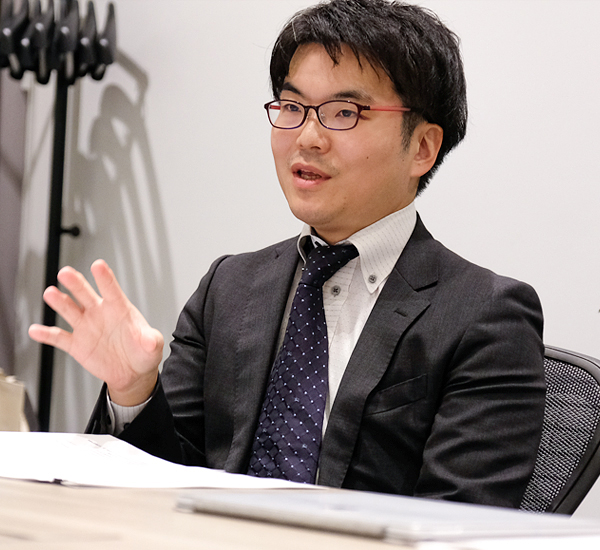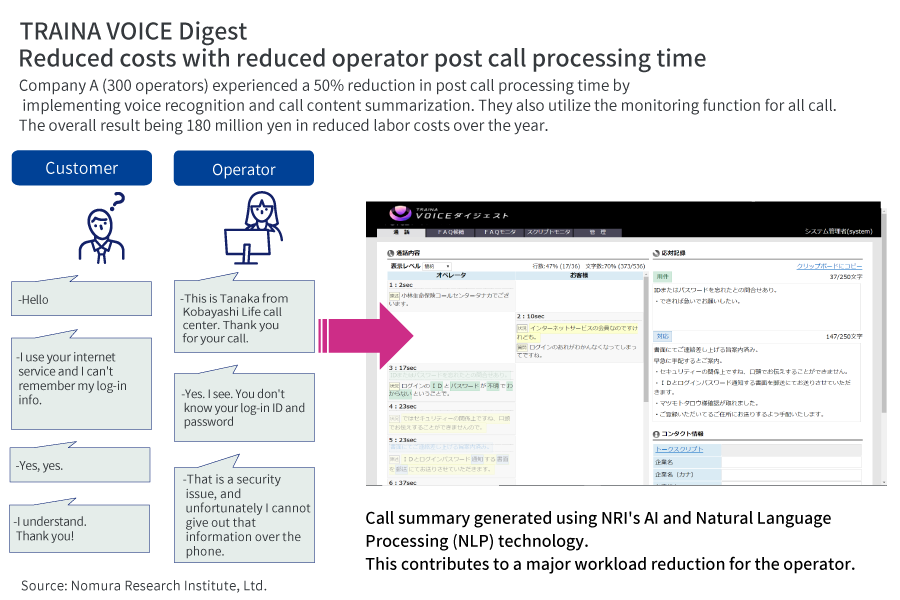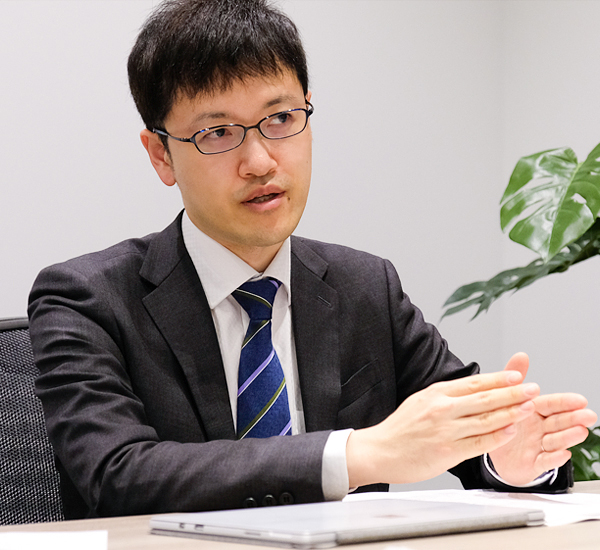
The Natural Language Processing Technology that Supports TRAINA, and its Possibilities: Changes to Contact Centers Brought on by AI (Part 3)
The Nomura Research Institute (NRI) system “TRAINA”, which uses AI (artificial intelligence), supports reduced workloads and increased efficiency at contact centers facing severe human resource shortages. TRAINA picks up and comprehends speech, searches for necessary information, gives advice, and takes records, but how does it accomplish these things? In our last installment of this three-part series introducing the present state of contact centers being changed by AI and possibilities for the future, we asked NRI’s Yuki Kitamura and Tomoyasu Okada, who have been involved in development for many years, about TRAINA’s technological characteristics and their aspirations for its development.
Changes to Contact Centers Brought on by AI (Part 1)
Changes to Contact Centers Brought on by AI (Part 2)
Language Processing Technology Built Up Over More Than 20 Years
--- What kind of product is TRAINA?
Kitamura: The TRAINA series is made up of several products. It includes “text mining” for analyzing writing obtained by transcription, “VOICE digest” for creating content summaries after the phone has been hung up, “FAQ knowledge” for searching for and analyzing questions that come up frequently, and the like. These products can be used in combination according to the required functions.
--- Which function of TRAINA elicits the greatest response?

Kitamura: That would be the function of creating summaries of the content of conversations. Recently, most smartphones have a function for typing up the text of your speech when you talk at them, so “recognizing and transcribing speech” is not so new to most people. TRAINA’s “VOICE digest” is able to create sentences summarizing the content that needs to be recorded from the dialogue between a customer and a communicator.
--- How is it able to do that?
Okada: Technology for dividing sentences into words in order to process the language that we use in daily life (natural language) is generally prevalent. TRAINA does not stop there; it automatically labels parts of dialogue between a customer and a communicator, e.g., “this is a question”, “this is a word of assent”, using sophisticated natural language processing to analyze the structure and meaning of the sentences. TRAINA’s predecessor was the text-mining tool “TRUE TELLER” that was released in 2001, and at its core is Japanese language processing technology built up over more than twenty years. We combined that with machine learning, deep learning, and other statistical AI technology that has advanced rapidly in recent years in order to realize a variety of functions.

Comprehensive Strength for Leveraging Cutting-Edge Knowledge in Business
--- Is Japanese more difficult to process than other languages?
Okada: I think it is. For example, the word “hai” can be a greeting, an indication of having heard something, or a response to a question depending on the context. Syntax is also problematic; for example, if you take the sentence “keikan ga jitensha de hashiru dorobo wo oikaketa (the police officer chased the thief riding a bicycle)”, it is unclear whether it is the police officer (keikan) or the thief (dorobo) who is on the bicycle (jitensha). In every language, there are cases where even humans aren’t sure of the correct interpretation, but that is particularly true of Japanese.
--- Is there anything you are particularly attentive to in research and development?

Okada: My role is to plan new products and functions, and to verify whether they are technologically feasible. Since progress in academia is marked in the field of AI in particular, in order to keep up with the latest technologies, I am always attending many academic conferences in Japan and abroad, reading top academic research papers, and learning about implementation. Having done that, rather than treating the technology itself as an end, I try to think comprehensively about how it can be applied to a customer’s business and work operations.
Expanding the Scope of Use Scenes with Customer Value as a Basis
--- Is there anything you are careful of in developing TRAINA?
Kitamura: We created TRAINA to be a multi-purpose product that can be used for any contact center operations, regardless of the industry or products being handled. Therefore, when a customer tells us that they want a certain function, we don’t immediately move to develop that function, but rather develop a firm understanding of the premise, namely, “Why is it necessary to develop that function?” and “How can we solve the problem experienced by the user?” Having done that, we thoroughly consider the “Why”, namely, what value do we aim to provide, and to whom, and we endeavor to create a user-friendly function. This is one aspect that differs somewhat from conventional IT system development, wherein functions are created following designated specifications.
--- Can TRAINA be used for operations other than those at contact centers?
Okada: The technologies of natural language processing and machine learning that serve as its base can be used in various operations. For example, we are broadening its scope of application to include operation support for office workers, use scenarios involving responding to inquiries at internal help desks and the like, business support and compliance handling, and more.
Kitamura: In our ordinary work, we ask questions, look things up, and arrange plans, and many of these tasks could be more conveniently and quickly achieved by automation than by using manpower and time. We hope to develop TRAINA into a product that can be used more wisely and conveniently in a wide variety of instances as a point of contact where people know “If I ask here, I will find most all of the information I need.”
Profile
-
Yuki Kitamura
-
Tomoyasu Okada
* Organization names and job titles may differ from the current version.